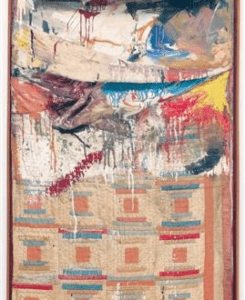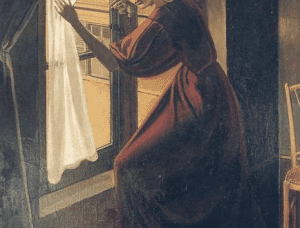(Skip to bullet points (best for students))

Born: 1969
Summary of Kara Walker
Kara Walker shocked the almost shock-proof art world of the 1990s with her wall-sized cut paper silhouettes right out of graduate school. At first glance, the individuals dressed in historical garb appear to be from a simpler era. That is, until we see the disturbing content: terrifying vignettes of American South history. Kara Walker’s art depicts mammies, pickaninnies, sambos, and other cruel stereotypes in a variety of scenarios that are usually violent and sexual in nature, drawing on sources ranging from slave testimonies to historical books. Her work was first panned by critics as obscenely vulgar, and the art community was split on how to respond.
Kara Walker is a painter who specialises in historical subjects (with a strong subversive twist). She virtually single-handedly resurrected Europe’s magnificent heritage of historical painting, producing scenarios based on history, literature, and the Bible, and making them fresh and relevant to the modern world. Walker’s big, long literary names call attention to her adoption of this tradition, as well as the work’s historical significance.
The silhouette – Walker’s shape – is crucial to the meaning of her work. It’s a powerful metaphor for the stereotype, which “says a lot with very little information.” as she puts it. Walker can also use the silhouette to deceive the eye. There is sometimes insufficient information to establish which figures’ limbs belong to which figures, or which are in front of and behind them, creating uncertainties that push us to rethink what we know and see.
Walker’s photographs are truly about today’s racism, as well as the huge social and economic disparities that continue to divide America. These are complicated, multi-layered compositions that reveal their meaning slowly and over time, more like puzzles than one-liners.
Walker’s work is highly influenced by storytelling traditions, yet she freely combines reality and fiction, relying on her creative imagination to complete the image.
Childhood
Walker, the daughter of a painter, was born in 1969 into a family of academics in Stockton, California, and showed an early interest in becoming an artist at the age of three. At the age of 13, she relocated to Stone Mountain, Georgia, with her parents after her father obtained a post at Georgia State University. Stone Mountain still hosted Klu Klux Klan rallies, in stark contrast to the multi-cultural atmosphere Walker had seen in coastal California. “I was called a ‘nigger,’ told I looked like a monkey, accused (I didn’t know it was an accusation) of being a ‘Yankee.'” Walker recounts in her new high school. Walker felt out of place, alienated, and pressured to fit into a stereotype in a culture that didn’t seem to match her. She sought refuge in the library and in books, where illustrated narratives of the South guided her toward a deeper knowledge of her new surroundings’ customs and traditions.
Early Life
Walker studied painting and printing at the Atlanta College of Art, and in reaction to pressure and expectation from her professors (a double standard sometimes applied to minority art students), she concentrated on race-related topics. She went on to the Rhode Island School of Design for graduate school, where she broadened her work to incorporate sexual and racial issues based on depictions of African Americans in art, literature, and historical tales. Walker, a seasoned researcher, began to rely on a wide range of materials, ranging from the picture to the pornographic novel, to construct her work. Other artists who tackled racial prejudices served as crucial role models for the nascent artist. Walker came across an old form while still in graduate school that would provide the foundation for her best early work. Cut paper silhouettes, which were popular in Victorian middle-class portraiture and illustration, had a streamlined beauty that, as Walker described it, “simplified the frenzy I was working myself into.”
Gone: An Historical Romance of a Civil War as It Occurred Between the Dusky Thighs of One Young Negress and Her Heart (1994) was Walker’s debut installation, and it was a critical success that led to representation with a prominent gallery, Wooster Gardens (now Sikkema Jenkins & Co.). Her success was cemented by a succession of subsequent solo exhibits, and she was awarded the MacArthur Foundation Achievement Award in 1998. Walker encountered significant criticism to her employment of the racial stereotype, despite a constant stream of achievement and plaudits.
Betye Saar, the artist famed for equipping Aunt Jemima with a weapon in The Liberation of Aunt Jemima (1972), one of the most powerful and memorable applications of racial stereotyping in 20th-century art, was one of the most vociferous opponents of Walker’s work. Nonetheless, Saar believed Walker had gone too far, and he organised a campaign criticising Walker’s use of racist themes in an open letter to the art community, asking, “Are African Americans being betrayed under the guise of art?” Walker’s Negress Notes (Brown Follies, 1996-97) watercolour series was harshly condemned in a wave of unfavourable reviews, which objected to the violent and sexually explicit nature of her paintings.
Saar and other critics voiced their worry that the art accomplished little more than reinforce negative preconceptions, thus turning back the clock on American race portrayals. Others supported her, praising her desire to reveal the absurdity of preconceptions, as political activist and conceptual artist Barbara Kruger put it, “turning them upside down, spread-eagle and inside out”
Mid Life
Walker, who is still in the middle of her career, continues to work steadily. Despite having been a celebrity since she was in her twenties, she has kept a modest profile. She married (and later divorced) Klaus Burgel, a German-born jewellery designer and RISD professor, in 1996, and they had a daughter, Octavia. Walker has revealed in interviews throughout the years that she plans each project with great care and accuracy. They also exude a genuine warmth and wit that, given the gravity of her work, one might not anticipate.
Light and projection-based installations that include the viewer’s shadow into the picture, making it a dynamic component of the work, are among recent efforts. In the summer of 2014, Walker completed his most ambitious piece to yet, a massive sculptural installation that was on display for many months in the former Domino Sugar Factory. Walker has been a committed mentor to rising artists as a professor at Columbia University (2001-2015) and then as Chair of the Visual Arts department at Rutgers University, urging her students “to live with contentious images and objectionable ideas, particularly in the space of art.”
Famous Art by Kara Walker
Gone: An Historical Romance of a Civil War as it Occurred b’tween the Dusky Thighs of One Young Negress and Her Heart
1994

This large-scale wall work, the artist’s first entry into the New York art scene, showcases her trademark style. The work’s epic title refers to a passage in Thomas Dixon, Jr.’s The Clansman (a foundational Ku Klux Klan text) devoted to the manipulative power of the “tawny negress,” as well as Margaret Mitchell’s Civil War-set Gone with the Wind (1936) and a passage in Thomas Dixon, Jr.’s The Clansman (a foundational Ku Klux Klan text) devoted to the manipulative power of the “ta The tableau’s shape, with silhouetted individuals dressed in 19th-century garb bending toward one another beneath the moon, evokes a fairy-tale romance. When we see the vivid representations of sex and violence that surface on closer scrutiny, the tableau falls short of its promise.
No mere words can Adequately reflect the Remorse this Negress feels at having been Cast into such a lowly state by her former Masters and so it is with a Humble heart that she brings about their physical Ruin and earthly Demise
1999

In an interview about this work, Walker remarked, “I wanted to make a piece that was incredibly sad,” “I wanted to make a piece that was about something that couldn’t be stated or couldn’t be seen.” says the artist. White swans appear against a dark background, gleaming against the black. As our eyes adapt to the light, we notice that the swans’ necks have dark shadows of human heads connected to them. Three blind individuals flank the swans, one of whom is removing her eyes, and to the right, a woman raises her arm in a triumphant gesture that resembles Delacroix’s Lady Liberty Leading the People.
A Subtlety, or the Marvelous Sugar Baby an Homage to the unpaid and overworked Artisans who have refined our Sweet tastes from the cane fields to the Kitchens of the New World on the Occasion of the demolition of the Domino Sugar Refining Plant
2014

The public arts group Creative Time commissioned Walker’s largest and most complex piece to yet, which was shown in what was formerly the world’s largest sugar refinery. With protruding genitals that hypersexualize the sphinx-like figure, the colossal shape, covered in white sugar and on display at the abandoned Domino Sugar facility in Williamsburg, Brooklyn, suggested the racial stereotype of “mammy” (nurturer of white families). Sculptures of young black boys made of molasses and resin accompanied her throughout the show, which melted away in the July heat.
BULLET POINTED (SUMMARISED)
Best for Students and a Huge Time Saver
- Kara Walker shocked the almost shock-proof art world of the 1990s with her wall-sized cut paper silhouettes right out of graduate school.
- At first glance, the individuals dressed in historical garb appear to be from a simpler era.
- Kara Walker’s art depicts mammies, pickaninnies, sambos, and other cruel stereotypes in a variety of scenarios that are usually violent and sexual in nature, drawing on sources ranging from slave testimonies to historical books.
- Her work was first panned by critics as obscenely vulgar, and the art community was split on how to respond.
- Kara Walker is a painter who specialises in historical subjects (with a strong subversive twist).
- She virtually single-handedly resurrected Europe’s magnificent heritage of historical painting, producing scenarios based on history, literature, and the Bible, and making them fresh and relevant to the modern world.
- Walker’s big, long literary names call attention to her adoption of this tradition, as well as the work’s historical significance.
- The silhouette – Walker’s shape – is crucial to the meaning of her work.
- It’s a powerful metaphor for the stereotype, which “says a lot with very little information.” as she puts it.
- Walker’s work is highly influenced by storytelling traditions, yet she freely combines reality and fiction, relying on her creative imagination to complete the image.
Born: 1969
Information Citations
En.wikipedia.org, https://en.wikipedia.org/.
Recommend0 recommendationsPublished in Artists, Resources







Responses